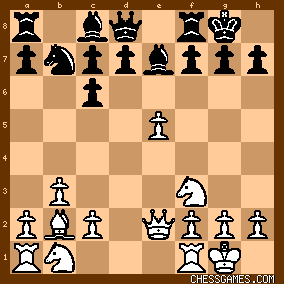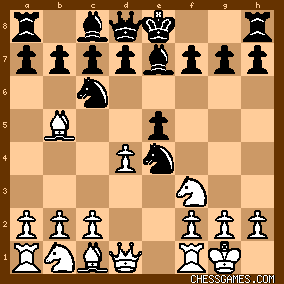|
< Earlier Kibitzing · PAGE 2 OF 2 ·
Later Kibitzing> |
| Oct-04-10 | | Ferro: IN SPITE OF... |
|
| Oct-04-10 | | Ferro: I..... |
|
| Oct-04-10 | | Once: This game is an old favourite. I really admire the way that Lasker uses threat after threat to grind white down, and then to end with a sparkling combination. |
|
| Oct-04-10 | | goodevans: <Tarrasch: "White just manages to avoid the loss of a piece"> History is written by the victors, and never more so than in chess where games were often portrayed as an inexorable journey to the inevitable conclusion. Tarrasch would have it that even the loser's good moves were some sort of fluke rather than a resource he had seen and relied upon several moves earlier. Fortunately bias in commentary is much rarer now, perhaps because of the contribution made by the silicon monsters. |
|
Oct-04-10
 | | chrisowen: Sand in time flavored a gritty black rook queen attack. EL read sure the manual dining bloated. Knight tour in fine style sacrifice bold champ to net it. Wait tip-off hes pawn seals lamp raise floor whites king stuffed pudding and pie. Bald harrowing queen sticks blood in the gill you him axed! |
|
| Oct-04-10 | | drleper: <goodevans> I think Tarrasch's comment is fair here. White's 14.Ne4? allowing 14...d5 and the ensuing play suggests that he probably wasn't aiming for 17.Qa6, but rather that it was the only option to stay in the game (hence the "avoiding the loss of a piece"). If you look at the position after 13.Rfe1 and then after 15...Ba3, you see that black has moved 3 pieces, while the white pieces are essentially unmoved! The result was a pretty strong positional advantage for black (those central pawns stifle the white pieces and create a nice outpost on d3). While there were surely better moves and resources for white, this is one of those games where it really does feel like black is marching towards an inevitable victory. |
|
| Oct-04-10 | | kevin86: A good game by the good doctor-surgery at its finest. BTW,wouldn't that make a sim-ex tournament "meatball surgery? |
|
| Oct-04-10 | | rapidcitychess: Quite nice. |
|
| Oct-04-10 | | hstevens129: If instead of 30.Kxh3, I have
30.Kf2 Rxf3+
31.Kxf3 h4
32.Nf1 Qe4+
33.Kf2 Rf8+
34.Ke1 Rxf1+
35.Kd2 Rxd1+
36.Rxd1 and Black has a decisive material advantage |
|
| Oct-04-10 | | GRANTZIERER: I voted against the pun in game of the day pun voting... I guess the guy showed me. |
|
| Oct-04-10 | | SugarDom: This porridge is too cold??? |
|
| Oct-04-10 | | apexin: this is a truly terrible game by white. |
|
| Oct-05-10 | | Once: <SugarDom: This porridge is too cold???> From Golidilocks and the three bears. She tried Daddy Bear's porridge but it was too hot. She tried Mummy Bear;s porridge, but it was too cold. But Baby Bear's porridge was just right. So she ate the lot... |
|
Mar-09-11
 | | GrahamClayton: Lasker' play from moves 14 onwards resembles a coiled spring that is let loose with full effect. Every move has a direct threat which White has to meet, eg 15.♘g3 ♗b4 using the discovered attack to win the exchange, for example. |
|
Feb-03-16
 | | offramp: I also first saw this game in an Inrving Chernev book but it was The Most Instructive Games of Chess Every Played, where I think its title was <Every Move A Threat>. It's amazing how the black ♘ from g8 goes to b7, as often happened in that old Berlin, but quickly manages to reach g2! It's quite a sprint. |
|
| Feb-03-16 | | JimNorCal: <offramp>: "It's amazing how the black knight from g8 goes to b7" This was the main line at that time, right? Wow. A main line that results in a knight being deposited on b7. What were they thinking? |
|
| Feb-03-16 | | Granny O Doul: The Nf6-e4-d6-b7 thing was the main line until rather recently. Korchnoi even played it in his '81 match with Karpov. |
|
Feb-04-16
 | | offramp: <JimNorCal: <offramp>: "It's amazing how the black knight from g8 goes to b7"
This was the main line at that time, right? Wow. A main line that results in a knight being deposited on b7. What were they thinking?> It is a bit odd, but as <Granny O Doul> says it was used as recently as
Karpov vs Korchnoi, 1981, and even after that. Lasker wouldn't have played anything suspect, of course. I remember that there used to be a very flaky looking line in the Queen's Indian. But once Miles found the killer knock-out blow it disappeared forever: Miles vs Beliavsky, 1986. |
|
Feb-04-16
 | | perfidious: In Reinfeld's collection of Tarrasch's best games, he gave a game in one of these Berlin lines where Black played ....Nf5 rather than the conventional ....Nb7 and came to grief. |
|
Feb-07-16
 | | keypusher: <JimNorCal: <offramp>: "It's amazing how the black knight from g8 goes to b7"
This was the main line at that time, right? Wow. A main line that results in a knight being deposited on b7. What were they thinking?> Here is what Lasker said about the position after ...Nb7: <We have now come to a critical stage. Black's pieces have retired into safety, ready, with one single move, to occupy positions of importance. White, on the contrary, has the field to himself, but he can do nothing for the moment, as there is no tangible object of attack. Various efforts have been made to show that White has the superior position. I do not believe White has any advantage, and am rather inclined to attribute the greater vitality to to the party who has kept his forces a little back. > Tarrasch expresses a very different view in the tournament book: <If a Knight has made no fewer than four of the first eight opening moves in order to find itself afterward on the unbelievable post of b7, that seems to me so laughable that I cannot understand how this method of development can have been accepted as normal after many decades.> Solomon Hecht also wrote a very funny critique of this defense in <Telling off the World Champion>, reprinted in <The Fireside Book of Chess.> |
|
| Nov-29-16 | | chessrookstwo: A clean operation by the doctor Lasker .smoked him |
|
Mar-18-18
 | | Honza Cervenka: 14.Ne4 was a mistake. Tarrasch's suggestion 14.Qf1 played against him in Vienna by Schiffers two years later is definitely better but 14.Nf1 or 14.Nc4 deserve attention too. |
|
| Sep-20-18 | | EmanuelLasker: Lasker played flawlessly. One of his best and most instructive games, in my opinion. |
|
Dec-05-20
 | | Eggman: The position after 10.Bb2.

click for larger viewIn his 1965 book The Most Instructive Chess Games Ever Played, Irving Chernev disapproves of 9.b3 & 10.Bb2. Chernev doesn't see a future for the dark-squared bishop on the long diagonal in view of White's the obstructive e5-pawn. I notice, however, a decent number of games on the Chessgames.com database reaching the diagrammed position, and it makes me wonder: is putting the bishop on b2 viable as a restraining move? The idea would be to discourage Black from advancing his queen pawn owing to the fact that the capture exd6 would then open the long diagonal for White's bishop. What it comes down to for me is this: is there such a thing as a “mysterious bishop move”, whether or not 10.Bb2 could be justified as such? |
|
Dec-18-21
 | | kingscrusher: This old Berlin line seems much more exciting in terms of maintaining complexity than the more modern line which aims to have the Queens off. 5...Be7 is more exciting than 5...Nd6
I must try this line - also it is fun to aim to fianchetto a knight. According to Stockfish as well, Lasker's line is only a slight advantage for White Moritz Porges - Emanuel Lasker 0-1 1.0, Nuremberg Nuremberg GER 1896

click for larger viewAnalysis by Stockfish 14:
1. ⩲ (0.53): 6.Qe2 Nd6 7.Bxc6 bxc6 8.dxe5 Nb7 9.Nd4 0-0 10.Nc3 Bc5 11.Be3 Qe8 12.Nf3 Bb6 13.Qd3 d5 14.Rfe1 h6 15.h3 Be6 16.b4 a5 17.a3 Qe7 18.Bxb6 axb4 19.axb4 cxb6 20.Nd4 Rxa1 21.Rxa1
White is slightly better
(Gavriel, 18.12.2021)
You can literally see approval by the latest Stockfish of the Knight fianchetto It seems Lasker was well ahead of his time - and our time ! |
|
 |
|
< Earlier Kibitzing · PAGE 2 OF 2 ·
Later Kibitzing> |





